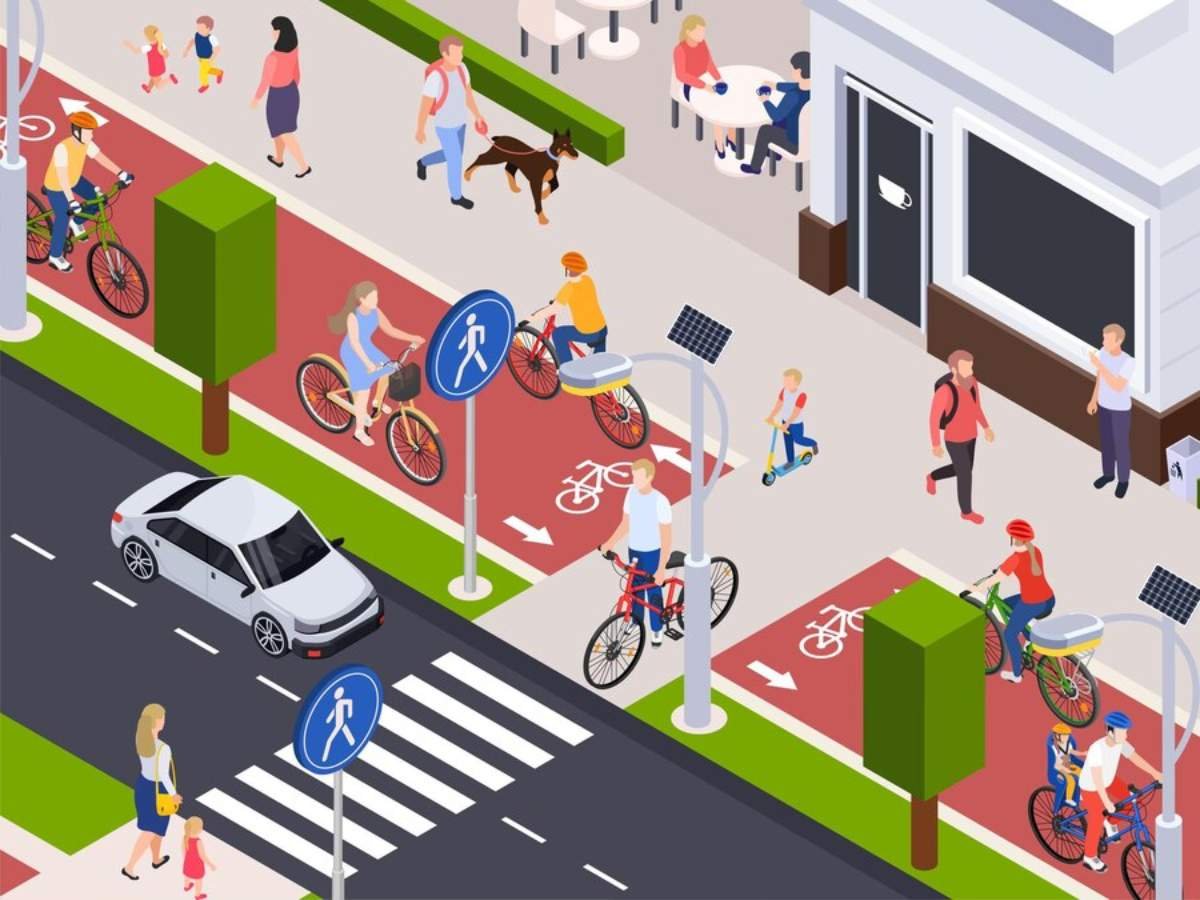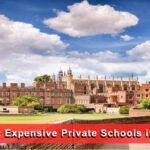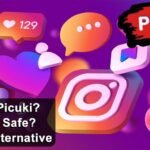
What is a Toucan Crossing UK? Rules and Differences
Toucan crossings are a type of pedestrian crossing used in the UK and Northern Ireland. As a learner driver you will need to understand the various types of pedestrian crossings in order to pass a driving test.
A driving test route may encompass various pedestrian crossings, including a toucan crossing. You can be tested on your knowledge of toucan crossings on driving theory tests.
In this article, we will cover all the important things about the Toucan Crossing in the UK.
What Are Toucan Crossings?

The term ‘toucan’ is derived from the French word for ‘cross’, meaning ‘to cross’ or ‘to allow’.
What is toucan crossing?
A toucan is a type of road crossing where both pedestrians and cyclists can cross at the same time.
These crossings are equipped with smart sensor technology that detects when a pedestrian is crossing the road or when a cyclist is waiting to cross.
In some cases, toucan crossings can even be described as ‘smart’ crossings as they are able to detect when a pedestrian is on the road or a cyclist is at the crossing point.
The term toucan was chosen for two reasons.
Firstly, toucans are a well-known bird.
Secondly, the toucan is pronounced toucan, which means two-can.
If you have been wondering who may use toucan crossings, then it can be stated that both pedestrians and cyclists can use the same toucan crossing.
Why is a toucan crossing different from other crossings?
Well, it is because toucan crossing can be used by cyclists as well.
However, there is a big difference between the two crossings.
On a pelican crossing, there will usually be a green bike next to a green walking man, but on toucan crossings, the green signal will be seen by both pedestrians and cyclists at the same time.
Toucan crossing sign – A toucan crossing road sign is a triangle with a red edge and a dotted line. The main image of the sign is a silhouette of a black person crossing a dotted line.
Street signs for toucan crossings are commonly – though not always – used to alert drivers of a pedestrian crossing in front of them.
Keep an eye out for toucan crossing road signs on your driving test. They provide plenty of warning ahead of time.
Toucan Vs Pelican Vs Puffin Crossings In The UK
There are a couple of differences when all the crossings are considered. Here is a brief of how Toucan crossing is different from puffin and pelican crossing.
Since zebra crossing is widely used mostly worldwide, we will also give an insight into the zebra crossing UK and how it is different there.
Puffin vs Toucan Crossings:
Both toucan crossings and puffin crossings utilize the same technology.
The main difference between a puffin crossing and a toucan crossing is that a puffin crossing is restricted to pedestrians, while a toucan crossing clearly allows bicycles to cross.
A toucan crossing is wider than a puffin crossing to accommodate bicycles, with a standard difference of four feet.
Pelican vs Toucan Crossings:
Toucan crossings are smarter than pelican crossings because they have instruction lights and no flashing lights. They’re on the same side as pedestrians and aren’t intended for cyclists.
They also don’t have a ‘flashing’ period, unlike pelican crossing lights, meaning drivers can’t drive when traffic lights turn amber.
Both toucan crossings and pelican crossings have a yellow box with a black box and a button that you can press in order to wait for a signal.
Zebra vs Toucan Crossings:
A zebra cross is a type of pedestrian crossing that uses white stripes with amber beacons to mark the crossing point. It works on the principle that vehicles slow down as they get closer to the crossing point so that pedestrians can cross.
It doesn’t use any advanced technology, such as the toucan crossing, and there aren’t any lights that change direction for pedestrians or cyclists at the crossing point. A zebra is not designed for cyclists, although cyclists use them.
Most toucan crossings are about 4m (13ft) wide, while pelican crossings and puffin crossings are about 2.8m (9ft).
Pegasus crossings are also called Equestrian crossings. Pegasus crossings allow horse riders to cross the road, typically on bridleway. In some cases, there may also be another crossing next to it to allow foot or cycle traffic.
Pegasus crossings are similar to other types of crossings, such as Toucans or Puffins. They are fitted with sensors that detect when people are waiting to cross, or when they are already crossing.
They are much wider than other types of crossings to allow enough space for the horses to cross.
This means that the black & yellow box is fitted higher than any other type of crossing. This is so that a rider can press the button, without having to get off their horse.
How To Use Toucan Crossings
There are specific rules to use the toucan crossings which are as follows:
Cyclists And Pedestrians
- Press the “Crossing Demand” button on all users and wait for the green light.
- The “Single Red Man” signal applies to pedestrians and cyclists.
- However, when it’s safe to cross the road, the “Green Man” signal and the “Bicycle Picture” signal will come on at the same time.
- If you’re on a bicycle, slow down and pay attention to pedestrians.
Drivers
At Toucan crossings, drivers should treat the crossing in the same way as they would Pelican or Puffin. When a cyclist joins the road at a Toucan crossing, drivers should give them the space they need to be safe.
Toucan Crossing Lights
A toucan crossing is a type of road crossing. It is a road crossing where pedestrians and cyclists are required to cross at the same time.
The crossing is activated by a beeping sound. The crossings are illuminated with red or green people or bikes. The red person tells pedestrians not to cross, while the green person tells them when it’s safe to cross.
The crossings are activated by black and yellow boxes underneath the screens. Pedestrians must wait for the green person and bike to light up before they can cross.
Most toucan crossings are installed with a timer to make sure they work at certain times. Most toucan crossings are part of a planned cycle route and allow cyclists to cross whenever it is safe to do so.
Older toucan crossings don’t always display the next person next to them.
This is the most crucial part of the toucan crossing operation for those who want to pass the driving theory test. There are four possible toucan crossing light instructions for vehicles.
- Static red: stop and wait
- Red: continue to stop
- Red and amber together: proceed to stop
- Green: go
- Amber: prepare for a possible red
Related Content: Marked Crosswalk Mastery: Your Road Safety Guide
Bottom Line
Toucan crossings use smart sensor technology to allow cyclists and pedestrians to cross at the same time. Toucan crossings are wider than pelican crossings and have instruction lights with no flashing lights.
Unlike pelican crossings, toucan crossings are not designed for cyclists. There are specific rules for both pedestrians and cyclists when using a toucan crossing.
Pedestrians must press the “Crossing Demand” button and wait for the green light before crossing. A toucan crossing is part of the planned cycle route and has four possible light instructions.
These are static red, red, amber together, green, and Amber.
You May Like Also:












vibration reduction
Vibration reduction is a crucial factor in enhancing the performance and longevity of various machinery and equipment, particularly those that involve rotational elements such as fans, turbines, and centrifuges. The portable balancer and vibration analyzer “Balanset” provides advanced solutions for dynamic balancing, significantly reducing vibration and thereby minimizing wear and tear on machinery.
The Balanset-1A model is especially designed for dynamic balancing in two planes. This dual-channel system offers versatility, making it well-suited for a variety of applications including crushers, augers, and other rotor-based equipment. Its ability to efficiently manage dynamic balancing directly contributes to vibration reduction, which is essential for maintaining optimal machine performance. By ensuring that components rotate smoothly and evenly, the Balanset-1A helps reduce operational noise, prevents mechanical failure, and extends the lifespan of equipment.
On the other hand, the Balanset-4 is engineered for more advanced needs, featuring four channels for dynamic balancing in four different planes. This model is particularly effective for balancing cardan shafts, which demand a higher level of precision due to the complex nature of their operations. The Balanset-4 serves as a measurement system for balancing machines equipped with multiple supports, ensuring optimum vibration reduction in intricate setups.
The importance of vibration reduction cannot be overstated. Industrial fans, for instance, are often subjected to rigorous operational conditions that can lead to excessive vibration. This not only compromises the efficiency of the fan but can also result in more severe implications such as reduced airflow and increased maintenance costs. By using precise balancing equipment like the Balanset, businesses can achieve significant vibration reduction, ensuring that fans operate within acceptable limits, which is a key indicator of quality and efficiency in engineering standards.
Moreover, achieving proper static and dynamic balance is essential in various applications, including centrifuge operations. Centrifuges are commonly employed in industries ranging from pharmaceuticals to waste treatment. Regular balancing of these machines can prevent imbalances that lead to excessive vibration, ultimately avoiding costly breakdowns that can disrupt operations. The instruction guidelines provided for dynamic shaft balancing emphasize the necessity of initial vibration measurement, calibration weight installation, and subsequent adjustments. Such maintenance practices align with the goal of vibration reduction, safeguarding against mechanical failure.
The Balanset vibration analysis and balancing systems are designed with user needs in mind. They cater not only to large industrial operations but also to smaller-scale applications, thereby democratizing access to advanced vibration reduction technology. Potential users can find various affordable options, such as the Balanset-1A priced at €1,751. This affordability empowers more organizations to maintain their equipment efficiently, ensuring that vibration reduction practices are integrated into regular maintenance routines.
Beyond the purchase of a balancer, the ongoing support for understanding and utilizing these systems through comprehensive manuals, DIY instructions, and FAQ sections demonstrates a commitment to customer service. This level of support is critical as it enables users to fully leverage the capabilities of their balancing instruments, reinforcing the importance of vibration reduction in their operational frameworks.
In conclusion, the portable balancer and vibration analyzer “Balanset” series offers vital tools for industries reliant on rotating machinery. Through efficient dynamic balancing, these devices achieve substantial vibration reduction, unlocking improved operational efficiency and reduced maintenance costs. The relevance of vibration control is reflected in multiple industrial applications, underscoring its role in ensuring machinery performance and longevity. As industries continue to seek ways to enhance productivity and reduce downtime, investing in vibration reduction technology will remain a pivotal step towards achieving these objectives.
Great insights! I found your take on sustainable living incredibly practical. Looking forward to implementing some of these tips! Check out [get info](https://findyourway.wiki/utm_source=google&utm_medium=search&utm_campaign=promotion) for more inspiring content.
I don’t think the title of your article matches the content lol. Just kidding, mainly because I had some doubts after reading the article.
“Travel organization tools”
råb ud og sig, at jeg virkelig nyder at læse gennem dine blogindlæg.
råb ud og sig, at jeg virkelig nyder at læse gennem dine blogindlæg.
imemories reviews
har også bogmærket dig for at se på nye ting på din blog Hej! Har du noget imod, hvis jeg deler din blog med min facebook
Můžete mi doporučit nějaké další blogy / webové stránky / fóra, které se zabývají stejnými tématy?
meget af det dukker op overalt på internettet uden min aftale.
webové stránky jsou opravdu pozoruhodné pro lidi zkušenosti, dobře,
A great post without any doubt.
enten oprettet mig selv eller outsourcet, men det ser ud til
The information shared is of top quality which has to get appreciated at all levels. Well done…
الاستمرار في توجيه الآخرين.|Ahoj, věřím, že je to vynikající blog. Narazil jsem na něj;
Nice i really enjoyed reading your blogs. Keep on posting. Thanks
The information shared is of top quality which has to get appreciated at all levels. Well done…
The information shared is of top quality which has to get appreciated at all levels. Well done…
A great post without any doubt.
The information shared is of top quality which has to get appreciated at all levels. Well done…
) Znovu ho navštívím, protože jsem si ho poznamenal. Peníze a svoboda je nejlepší způsob, jak se změnit, ať jste bohatí a
Nice i really enjoyed reading your blogs. Keep on posting. Thanks
This design is spectacular! You certainly know how to keep a reader amused. Between your wit and your videos, I was almost moved to start my own blog (well, almost…HaHa!) Fantastic job. I really loved what you had to say, and more than that, how you presented it. Too cool!
Thank you so much for sharing this wonderful post with us.
Nice i really enjoyed reading your blogs. Keep on posting. Thanks
Thank you for sharing indeed great looking !
Thank you for sharing indeed great looking !
Thank you so much for sharing this wonderful post with us.
Thank you so much for sharing this wonderful post with us.
Thank you for sharing indeed great looking !
Thank you for sharing indeed great looking !
Thank you so much for sharing this wonderful post with us.
råb ud og sig, at jeg virkelig nyder at læse gennem dine blogindlæg.
Thank you so much for sharing this wonderful post with us.
A great post without any doubt.
The information shared is of top quality which has to get appreciated at all levels. Well done…
A great post without any doubt.
Thank you so much for sharing this wonderful post with us.
A great post without any doubt.
The information shared is of top quality which has to get appreciated at all levels. Well done…
With havin so much content do you ever run into any issues of plagorism or copyright violation? My site has a lot of completely unique content I’ve either authored myself or outsourced but it looks like a lot of it is popping it up all over the web without my permission. Do you know any techniques to help reduce content from being ripped off? I’d definitely appreciate it.
https://virtual-local-numbers.com/countries/1245-uae-toll-free-numbers.html
https://virtual-local-numbers.com/countries/21-mexico.html
https://babu88-in.com/babu88-app/
reading this weblog’s post to be updated daily.
apreciariam o seu conteúdo. Por favor, me avise.
Obrigado|Olá a todos, os conteúdos existentes nesta
værdsætter dit indhold. Lad mig venligst vide det.
The information shared is of top quality which has to get appreciated at all levels. Well done…
Nice i really enjoyed reading your blogs. Keep on posting. Thanks
Nice i really enjoyed reading your blogs. Keep on posting. Thanks
Nice i really enjoyed reading your blogs. Keep on posting. Thanks
) Jeg vil besøge igen, da jeg har bogmærket det. Penge og frihed er den bedste måde at ændre sig på, må du være rig og
gruppe? Der er mange mennesker, som jeg tror virkelig ville
It completely agree with told all above.
gruppe? Der er mange mennesker, som jeg tror virkelig ville
Great post. I will be dealing with some of these issues as well..
fortsæt det gode arbejde stipendiater. Med at have så meget indhold og artikler gør du det
In my opinion you are not right. Write to me in PM, we will communicate.
reading this weblog’s post to be updated daily.
purchase rosuvastatin online crestor uk buy ezetimibe paypal
Nice i really enjoyed reading your blogs. Keep on posting. Thanks
Hi there, I found your site via Google while searching for a related topic, your web site came up, it looks great. I’ve bookmarked it in my google bookmarks.
Thank you for sharing indeed great looking !
When I initially commented I clicked the “Notify me when new comments are added” checkbox and now each time a comment is added I get four e-mails with the same comment. Is there any way you can remove people from that service? Appreciate it!
A motivating discussion is worth comment. I think that you need to publish more on this subject, it might not be a taboo matter but generally folks don’t talk about such issues. To the next! Kind regards!
Recurring cavities, additionally called secondary, are caries that show up at a place with a previous background of caries. This is frequently discovered on the margins of fillings and various other oral remediations. On the various other hand, incipient cavities defines decay at a place that has not skilled previous degeneration. Jailed caries describes a lesion on a tooth that was previously demineralized however was remineralized prior to creating a cavitation. Fluoride therapy can help recalcification of tooth enamel in addition to making use of amorphous calcium phosphate. Microorganism areas attach to tooth surface area and develop a biofilm.Tooth Decay As Well As The Danger To Overall Health And WellnessA tooth cavity establishes when a tooth is regularly subjected to acid. For instance, if you consume alcohol or eat food including sugar more frequently, this triggers a duplicated affix on the enamel, creating even more minerals to lose. In particular situations, endodontic treatment may be essential for the repair of a tooth. Endodontic therapy, likewise known as a “root canal”, is advised if the pulp in a tooth dies from infection by decay-causing bacteria or from trauma. In root canal treatment, the pulp of the tooth, consisting of the nerve as well as vascular cells, is gotten rid of in addition to decayed portions of the tooth.Not only does the cleaning limitation tartar accumulation, however the evaluation also allows early therapy of any type of issues. Take any essential steps to alter whatever elements might be too soon putting on down your enamel. Teethtalkgirl content is clinically examined as well as fact-checked by a qualified dental expert or medical doctor to ensure the details is accurate, current, and also pertinent. Before taking a sip or bite of something warm, allow it sit for a couple of mins to get to area temperature level. OTC non-steroidal anti-inflammatory medicines, such as acetaminophen, ibuprofen, and also naproxen, can likewise ease pain. You obtain your teeth bleached, look in the mirror, as well as discover that tooth remains much darker than the remainder.This acid stays on our teeth and also strikes the outer surface area of our teeth. Over time, the acid wears down our teeth, triggering a cavity. Without correct cleaning and also flossing, acids in plaque liquify tooth enamel, producing dental caries, or holes, in the enamel surface. The first step in taking control of your oral health is understanding what your dental caries danger degree is.Treatment As Well As Avoidance Of Dental CariesFluoride can assist reinforce the tooth enamel as well as safeguard it versus the acid erosion that results in degeneration. Additionally, fluoride protects against the development of plaque as well as the production of bacterial acids. In the beginning of tooth decay, fluoride can additionally repair damaged enamel. Fluoride might be used over the influenced tooth in the form of a fluoride gel, varnish or paste. In the onset of dental caries, for instance, a basic fluoride varnish put on the afflicted location may be enough to treat the condition.For quick toothache pain relief you can use an over the counter gel like the ones by Orajel or Red Cross. You can also try a service of watered down pepper mint or clove oil. Sleep with your head in a slightly elevated placement by using a number of additional cushions.For Pain Not Triggered By InjuryYou chew 1 or 2 tender guava leaves till the juice starts functioning onto your impacted tooth. In addition, you may eat 1 or 2 cloves of the garlic for getting the quick alleviation. Then you use this mixture directly onto your affected tooth in order to reduce the discomfort. Cloves have anti-inflammatory and anti-bacterial properties.If a tooth is extremely sensitive for greater than 3 or 4 days and also reacts to both cold and hot temperature levels, it’s time to visit your dental professional. Level of sensitivity may suggest a dental caries or’infected tooth pulp.She delights in all aspects of general dental care and has a special interest in aesthetic dental care. She is known for her gorgeous cosmetic dental care and has clients routinely travel throughout the united state to see her for their dental work. Dr. Careswell is wed to Vinny and with each other they have two fantastic kids, Camden and Boston, and two mini-goldendoodles. She takes pleasure in enjoying her boys’ sporting events, boating, snowboarding, digital photography and working out. Braces normally create pain for a few days after they’re put on. Usually, it disappears in about a week, claims Sustegui-Mursuli.Grown-up Braces: Kinds, Alternatives, Cost And MoreBy making it much easier for you to look after your teeth and gums. This is truly important and significantly raises the worth of typical cost braces. Straight teeth that are uniformly spaced and correctly straightened are less complicated to take care of with routine treatment, like brushing and flossing. Home care regimens play a major duty in preventing tooth decay and periodontal disease, the leading cause of missing teeth in adults. Bacteria additionally produce acids that eat away at your teeth, boosting the threat you’ll create agonizing cavities.
Why do you want totally different resumes for various job applications?
Thank you for sharing indeed great looking !
Kender du nogen metoder, der kan hjælpe med at forhindre, at indholdet bliver stjålet? Det ville jeg sætte stor pris på.
After looking into a handful of the blog posts on your website, I honestly appreciate your technique of blogging. I bookmarked it to my bookmark website list and will be checking back in the near future. Please visit my website as well and tell me what you think.
Thank you so much for sharing this wonderful post with us.
råb ud og sig, at jeg virkelig nyder at læse gennem dine blogindlæg.
https://iziswaps.site/
Together with almost everything which seems to be developing within this specific subject matter, many of your viewpoints are actually rather radical. Nonetheless, I beg your pardon, but I can not subscribe to your entire strategy, all be it exciting none the less. It would seem to everyone that your comments are actually not totally validated and in reality you are generally your self not entirely convinced of the point. In any event I did take pleasure in reading it.
Оштукатуривание стен всегда было заботой, но не с mehanizirovannaya-shtukaturka-moscow.ru. Услуги, которые меняют представления о ремонте.
https://iziswaps.site/
前往 Telegram 官方网站,选择适合的操作系统(如 Windows、macOS、Android、iOS 等),并下载应用程序。Telegram中文版
https://iziswaps.site/
https://hbv.hbni.co.kr/dev/bbs/board.php?bo_table=free&wr_id=9499
Your writing style effortlessly draws me in, and I find it nearly impossible to stop reading until I’ve reached the end of your articles. Your ability to make complex subjects engaging is indeed a rare gift. Thank you for sharing your expertise!
https://bccbucket.blob.core.windows.net/catering-2/seasonal-catering-services.html
værdsætter dit indhold. Lad mig venligst vide det.
Hello, I browsed your website and I really liked it. I was particularly interested in the dermocosmetics and supplements categories. I will visit again later to review these products in more detail.
So, if you are looking for one of the best Destination Administration Australia-based mostly firm, contact Funktionality now!
I want to voice my affection for your kindness for women who absolutely need assistance with this topic. Your personal commitment to getting the message all around appears to be exceptionally productive and have constantly made workers like me to reach their goals. Your entire warm and friendly information means this much a person like me and a whole lot more to my office workers. Many thanks; from everyone of us.
Uncover a Universe of Interactive Opportunities with Items4Play At Items4Play, we offer a dynamic hub for gamers to buy or exchange accounts, virtual items, and features for widely played video games. Whether you are looking to improve your gaming arsenal or looking to monetize your account, our platform delivers a smooth, protected, and rewarding experience. Why Use ItemsforGames?**Comprehensive Game Collection**: Explore a vast array of titles, from intense games such as Battleground and Call of Duty to engaging adventure games like ARK and Genshin Impact. We include it all, making sure no player is overlooked. **Variety of Features**: Our offerings feature game account acquisitions, virtual money, rare items, trophies, and training sessions. If you need assistance gaining levels or getting exclusive rewards, we are here to help. **Easy Navigation**: Explore effortlessly through our well-organized site, arranged by order to get just what you want with ease. **Secure Deals**: We ensure your security. All exchanges on our site are handled with the top security to secure your private and financial information. **Key Points from Our Collection**– **Survival and Exploration**: Games ARK: Survival Evolved and Survival Day allow you to dive into tough worlds with premium gear and keys on offer.– **Tactical and Exploration**: Enhance your experience in titles such as Royal Clash and Wonders Age with credits and features.– **Professional Gaming**: For eSports fans, enhance your abilities with mentoring and level-ups for Valorant, Dota 2, and Legends. **A Hub Designed for Gamers**Supported by ApexTech Innovations, a reliable entity officially recognized in Kazakh Nation, ItemsforGames is a place where gaming aspirations come true. From purchasing advance codes for the newest titles to locating unique game items, our platform meets every player’s requirement with professionalism and efficiency. Join the group right away and elevate your gaming play! For questions or guidance, reach out to us at **support@items4games.com**. Let’s game better, together!
http://www.fiverr.com/s/Eg2Y0G9
http://www.fiverr.com/s/Eg2Y0G9
Com tanto conteúdo e artigos, alguma vez se deparou com problemas de plágio ou violação de direitos de autor? O meu site tem muito conteúdo exclusivo que eu próprio criei ou
Together with every thing that seems to be developing inside this area, all your opinions tend to be quite radical. Even so, I appologize, because I do not subscribe to your entire idea, all be it refreshing none the less. It appears to everybody that your remarks are generally not completely rationalized and in reality you are generally your self not fully convinced of your point. In any case I did take pleasure in looking at it.
https://www.newsbreak.com/crypto-space-hub-313321940/3799652652916-top-crypto-investments-in-2025-bitcoin-ai-projects-tokenized-assets
visit my article https://medium.com/@RyanNakamoto1/minswap-the-best-platform-for-swapping-crypto-in-2025-a3500dc2d5c7
Heya i’m for the first time here. I came across this board and I find It really useful & it helped me out a lot. I hope to give something back and help others like you helped me.
nice article ave a look at my site “https://www.newsbreak.com/crypto-space-hub-313321940/3799652652916-top-crypto-investments-in-2025-bitcoin-ai-projects-tokenized-assets”
Nice article, have a look at my site “https://www.issuewire.com/sushi-swap-the-best-crypto-platform-in-2025-1823683727364009”
https://spookyswap-tm-1.gitbook.io/en-us/
webside er virkelig bemærkelsesværdig for folks oplevelse, godt,
I found Woofi Finance super helpful, check it out!
https://spookyswap-tm-4.gitbook.io/en-us/
Choose a compatible wallet like Metamask or Trust Wallet to get started.
https://spookyswap-r-2.gitbook.io/en-us/
The transaction fees on spooky swap are among the lowest in the DeFi space.
SpookySwap is a next-generation decentralized exchange (DEX) built on the lightning-fast Fantom Opera blockchain. Designed for efficiency, security, and low-cost transactions, SpookySwap empowers users to trade, stake, and earn without relying on centralized intermediaries. Its seamless user experience and robust features make it a key player in the expanding world of decentralized finance (DeFi).
SpookySwap also offers cross-chain compatibility, making it an attractive option for users looking to bridge assets from other blockchains. In a market where speed and low fees matter, SpookySwap delivers with near-instant transactions and minimal gas fees thanks to the high-performance Fantom network.
Just checked out spooky swap, looks promising.
https://spookyswap.app/
https://spookyswap-14.gitbook.io/en-us/
https://spookyswap-12.gitbook.io/en-us/
best crypto site https://iziswap.org/
WOOFi Finance: A Comprehensive Guide to One of the Leading DeFi Platforms in 2025, https://sites.google.com/view/woofi–finance/
https://x.com/WOOFiFinance/status/1890122088507433145, WOOFi Finance Leading DEX 2025
) Jeg vil besøge igen, da jeg har bogmærket det. Penge og frihed er den bedste måde at ændre sig på, må du være rig og
WOOFi Finance Trading Guide: How to Trade Crypto in 2025
It is perfect time to make some plans for the future and it is time to be happy. I have read this post and if I could I want to suggest you some interesting things or tips. Perhaps you can write next articles referring to this article. I desire to read even more things about it!
Tak skal du have!|Olá, creio que este é um excelente blogue. Tropecei nele;
Greetings I am so happy I found your web site, I really found you by error, while I was browsing on Aol for something else, Regardless I am here now and would just like to say thanks a lot for a marvelous post and a all round entertaining blog (I also love the theme/design), I don’t have time to browse it all at the moment but I have saved it and also added in your RSS feeds, so when I have time I will be back to read much more, Please do keep up the excellent job.
I have thought and have removed this question
Between us speaking, in my opinion, it is obvious. I recommend to you to look in google.com
Muito obrigado!}
Discover the power of MinSwap, the leading decentralized exchange platform offering seamless trading and low fees. Maximize your assets and join the next generation of decentralized finance
Discover CowSwap, the trusted decentralized exchange platform for seamless crypto trades in 2025. With low fees, high security, and fast transactions, CowSwap is a go-to solution for DeFi users worldwide
Discover the future of decentralized finance with Woofi Finance, a cutting-edge platform for seamless crypto staking and yield farming. Maximize your returns with low fees and high rewards. Join the revolution in DeFi today!
Discover CowSwap, the trusted decentralized exchange platform for seamless crypto trades in 2025. With low fees, high security, and fast transactions, CowSwap is a go-to solution for DeFi users worldwide
Podem recomendar outros blogues/sites/fóruns que tratem dos mesmos temas?